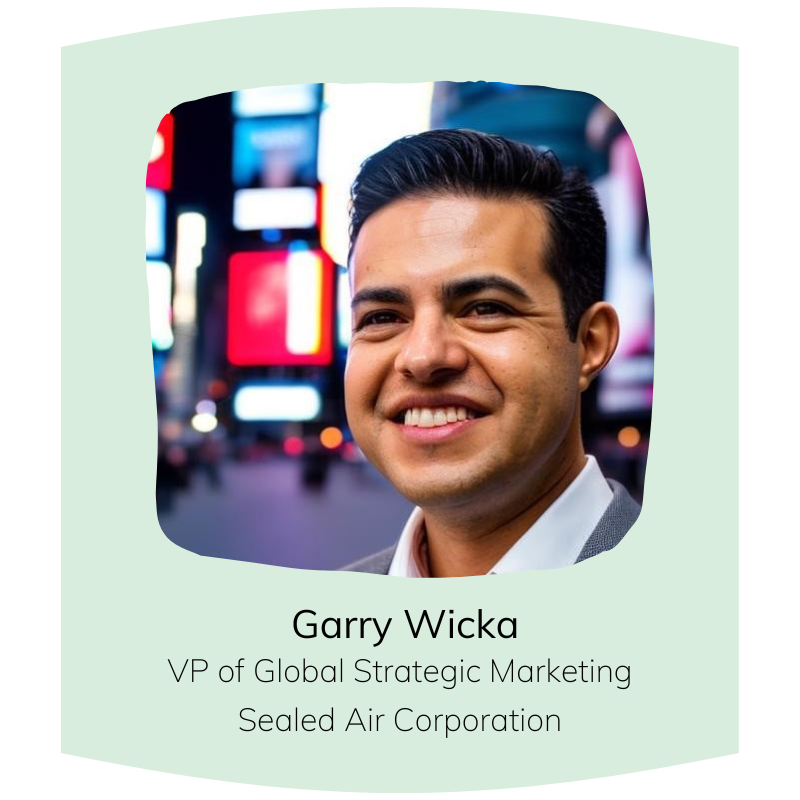A Wrap on the Packaging Industry in 2023
At Setup, we talk to a variety of Marketing experts in various industries. Surprisingly, there is a lot of overlap behind their schools of thought, advice, and noticeable trends. We recently attended the Packaging Expo in Las Vegas, and were inspired to talk to other marketing professionals within that industry. Jacob Resnick, the Marketing Manager at Viking Masek Packaging Technologies, and Garry Wicka, the VP of Global Strategic Marketing at Sealed Air, shared their thoughts on innovative strategies and what can be learned from the packaging industry in the interview below.
1. What innovative changes are happening in the Packaging space? What changes made are going to remain permanent moving forward?
TLDR: The packaging industry was leaning on traditional marketing methods for a long period of time. There is still an emphasis on people, but the marketing is led by customer-centric digital marketing strategies that are informed by robust data collection and seen in media directly made for the consumer (like how-to videos). Companies are also developing more eco-friendly, smart packaging that is less damaging to the environment and more efficient for supply chain tracking.
Resnick: The packaging industry arrived a little late to the digital marketing party, but it has been an exciting journey to see how it has transformed the way we do business.
Historically, a traditional marketing approach was standard in the packaging space. Marketing strategies were focused on cultivating relationships in person, event marketing, printed material, direct mail, and cold calling/emailing. The primary focus was shaking hands and meeting in person. Marketing was done by small teams and was driven by lots of guesswork and shots in the dark. As such, it was very difficult to measure the ROI of our efforts.
If you had a website, it would often serve as a product catalog rather than a sales tool with an abundance of product information to educate the end consumer.
This worked for a while, but eventually we realized that the old way of doing things was not on par with how modern consumers prefer to do business. While the need to meet in person is still very important, we saw that our customers were doing an immense amount of research online first. We simply did not have the digital resources required to meet the preferences of modern consumers, and that needed to change.
In an industry that champions automation and forward-thinking technology, the packaging sector displayed a certain measured reluctance in adopting modern marketing methodologies. However, this attitude has evolved over the past decade, bringing a transition to customer-centric digital marketing strategies. A focus on avenues like blogging, search engine optimization (SEO), downloadable resources, and social media has taken center stage. Viking Masek was among the first in the packaging equipment space to make this switch, and we now see many competitors following in our footsteps.
With this modern approach to marketing, our website now acts as an automated inbound lead generating machine. Beyond a mere product catalog, it now provides relevant educational content catering to all stages in the customer journey. We learn our clients’ questions and pain points and offer content that provides answers and solves their problems. Our approach is to work collaboratively with our customers and ensure they are as informed as possible before ever speaking to a sales person.
In an era where self-education is more prevalent than ever, we have seen a great deal of success with video marketing and how-to tutorials that help consumers understand packaging technologies. Additionally, with the data we now collect using robust CRM and marketing systems, our capacity to discern effective strategies has grown exponentially. The insights we’ve gained through data alone have made us more nimble and proactive in many departments across our organization.
We expect the focus on digital, customer-centric content will remain permanent going forward. This trajectory is destined to evolve, encompassing technologies like augmented reality (AR), virtual reality (VR), influencer-driven campaigns, and short form content.
Wicka: In the packaging space, we are witnessing several innovative changes that are reshaping the industry. One prominent trend is the increasing focus on sustainability and eco-friendly packaging solutions. Many companies are adopting renewable and other new innovative materials, reducing single-use plastics, and implementing recycling programs to minimize their environmental impact. These sustainable practices are likely to remain permanent as consumers continue to prioritize eco-conscious products and brands.
Moreover, there's a significant advancement in smart packaging technologies. This includes new types of digital design and digital printing capabilities, unique identifiers, and other intelligent components that enable better product tracking, quality control, and real-time communication with consumers. As these technologies evolve, they are likely to become standard features in packaging, enhancing supply chain efficiency and providing valuable data insights for marketers.
2. Are there other industries or companies outside your own that you have looked to for inspiration and why?
TLDR: It does not matter if a company is B2B or B2C, it matters what type of work they are doing, and if it is resonating with people. Some of the influential industries are technology, automotive, and food and beverage. The best inspiration can also arise from consumer feedback.
Resnick: Our business is B2B, so you’d think that we’d look to other B2B companies for inspiration, but we take a different approach. We recognize that we’re marketing to people, not companies. So we often look to the B2C sector for fresh ideas that connect with the consumer on a personal level. While our product is packaging machinery, we are in the people business.
We look at big tech companies for inspiration. They must be on the cutting-edge of marketing to stay relevant. By watching what they do, we can often adapt to the business climate and marketing trends with creative new ways to present our content.
We also rely heavily on the feedback of our customers. We want to know what they want to know and how they want to learn about it.
The high-end automotive industry has also been a source of inspiration. The characteristics of their target market often overlap with ours: Consumers that want a modern, fast, and efficient solution that will simplify and enhance their lives, and are willing to pay a premium to make it a reality.
Wicka: We find inspiration from various industries and companies that have successfully implemented innovative packaging strategies. One such industry is the technology sector. Tech companies often excel in creating sleek and functional product packaging that enhances user experience while maintaining a strong brand identity. Their attention to detail in design, material choice, and presentation serves as an excellent source of inspiration for us.
We also draw inspiration from the food and beverage industry. This sector has been proactive in adopting sustainable packaging practices, and has shown how eco-friendly solutions can resonate with consumers and positively impact brand reputation. Learning from their successes and challenges helps us refine our own packaging strategies.
3. What lessons can other industries learn from the Packaging space?
Resnick:
#1 - Question assumptions. Packaging can seem rather cut and dry, even unexciting to those that don’t work in the industry. But our workforce contains passionate, creative, driven people that truly take pride in helping their clients grow their brands and businesses.
#2 - Embrace change. A traditional approach to marketing was ingrained in the packaging industry for decades. Switching to a modern approach was not quick, inexpensive, or easy. But it has truly transformed how we do business.
#3 - Nimble thinking. Especially after the pandemic, we understand that the ability to quickly pivot our sales and marketing strategies is important. We must be comfortable with abandoning the tried and true in favor of what works now, today.
#4 - Focus on sustainability. Now more than ever, sustainability is top-of-mind, especially in an industry where packaging waste is a concern that cannot be ignored. Our packaging equipment can not only accommodate the latest in compostable and eco-friendly packaging, but our US headquarters is powered by a rooftop solar array.
Wicka:
#1 - Embrace Sustainability. Companies from various sectors can learn to prioritize sustainability by adopting eco-friendly packaging materials and minimizing their environmental footprint. Sustainability not only benefits the planet but also aligns with consumers' growing concerns about ecological responsibility.
#2 - Prioritize User Experience. Packaging plays a crucial role in enhancing the overall product experience. Industries can focus on creating functional, aesthetically pleasing, and user-friendly packaging that adds value to their products.
#3 - Utilize Smart Technologies. Integrating smart and digital packaging technologies can provide invaluable data and insights for companies.
#4 - Communicate Brand Values. Packaging is an excellent medium to convey a brand's values and story to consumers. Industries can learn to use their packaging as a canvas for branding, showcasing their commitment to quality, sustainability, and customer satisfaction.
#5 - Adaptability and Innovation. The packaging industry is constantly evolving to meet changing consumer demands and technological advancements. Other industries can learn from this adaptability and adopt an innovative mindset to stay relevant and competitive.
At the end of the day, all marketing should be people-oriented. Whether it is industrial, financial, or packaging, you are marketing to people and need to know what they care about and what resonates with them. Transitioning away from traditional methods while maintaining a human lens by using advanced technology to reach audiences and data to inform decisions is how the packaging industry will continue to thrive. It seems like the packaging industry is doing this and more. By recognizing that they are a huge contributor to waste, focusing on sustainability and efficient packaging practices makes them more attractive and more likable to their buyers.
How are you innovating in your industry’s space? Is it working?
































Over the past year, we’ve watched the following patterns emerge across seemingly unrelated sectors: rising consumer expectations, demand for authenticity, growing complexity, and the tension between automation and human connection.
We interviewed multiple marketers from an array of industries in our blogs below, and we discovered consistent trends across the board. Check out all of our industry blogs throughout 2025 from leaders at Blackbaud, Hiscox USA, Mimedx, MONPURE, Kimberly-Clark Professional, and more.